
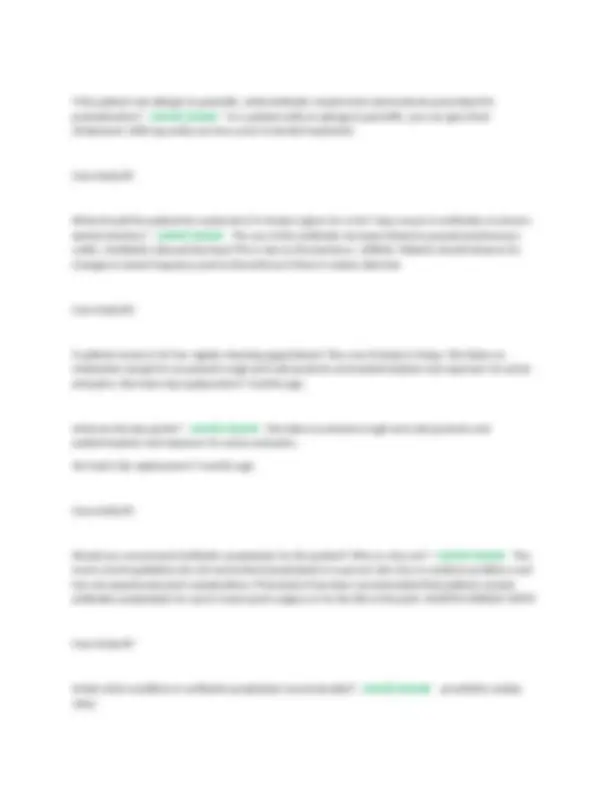
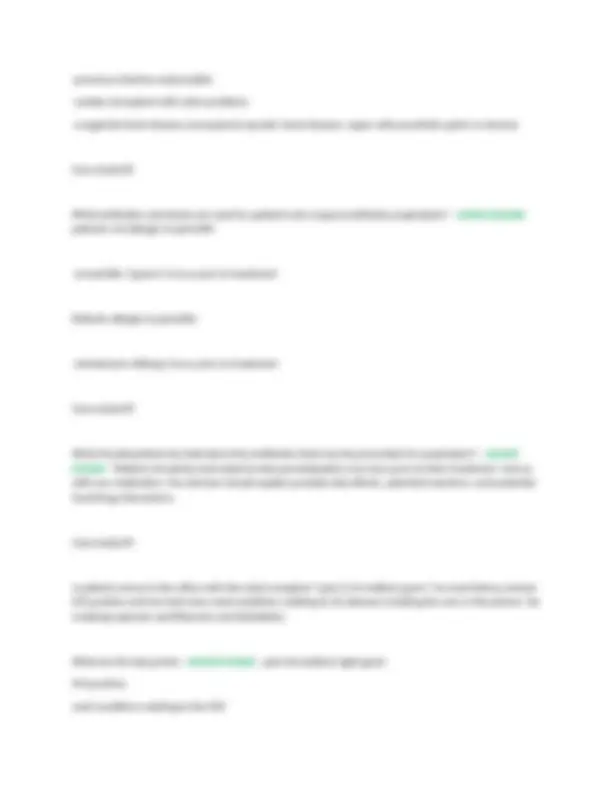
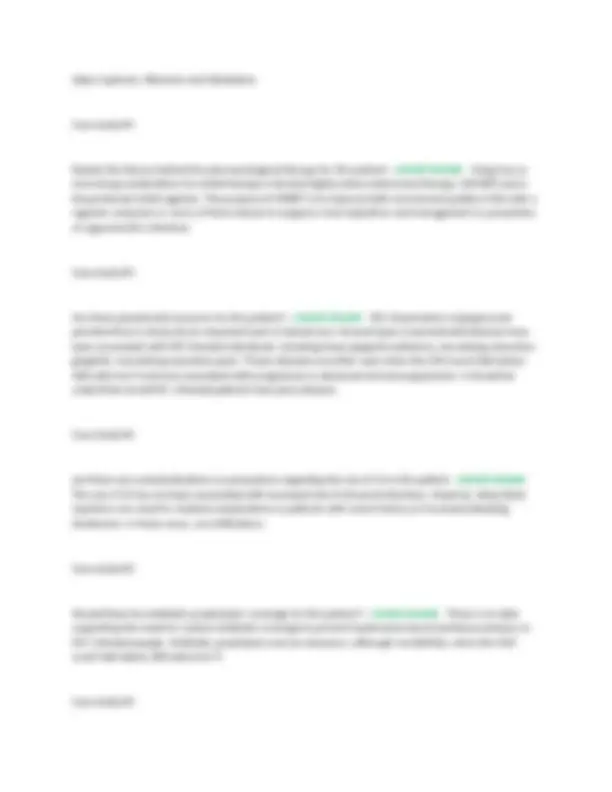
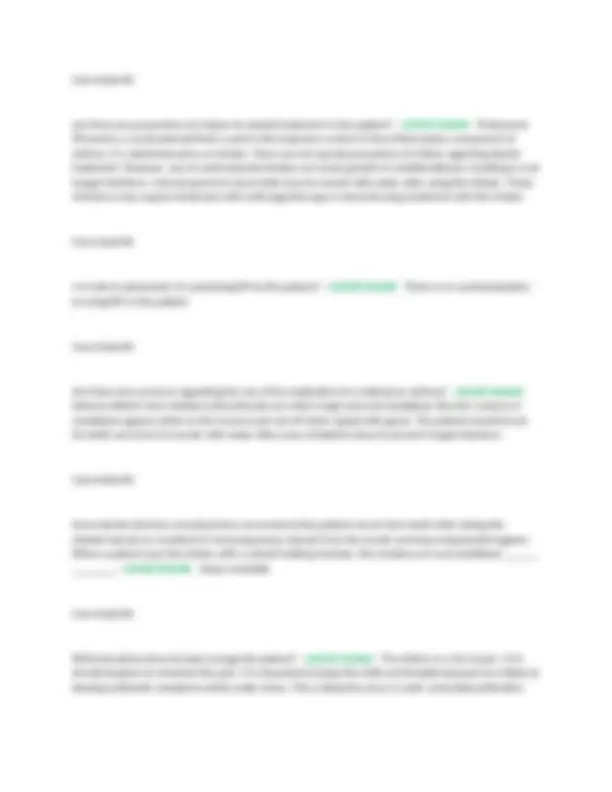
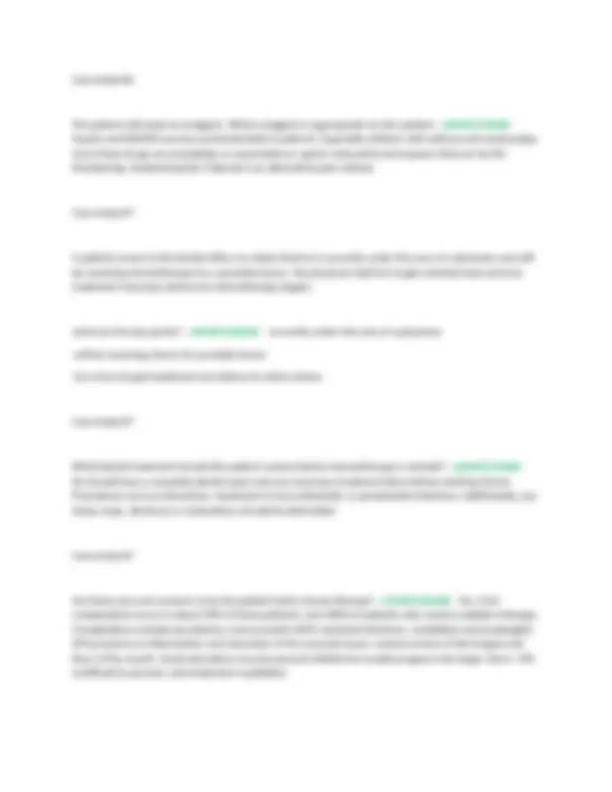
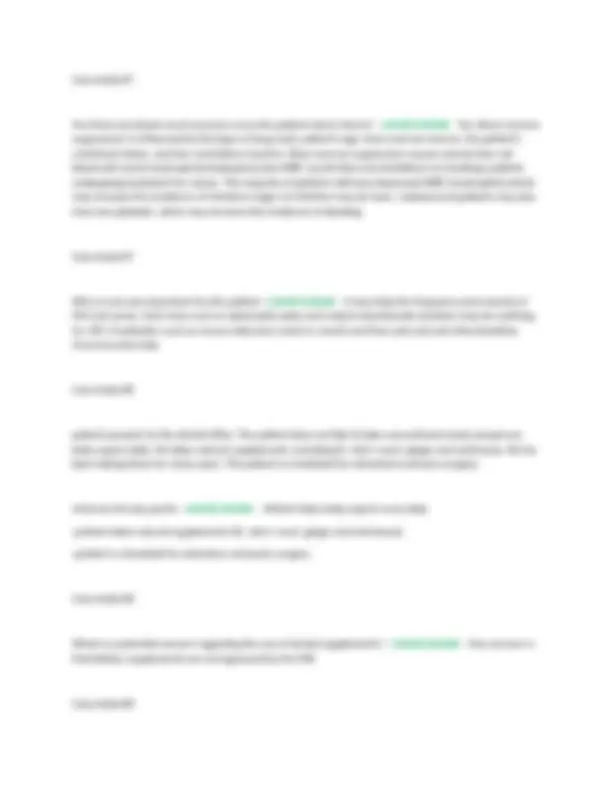
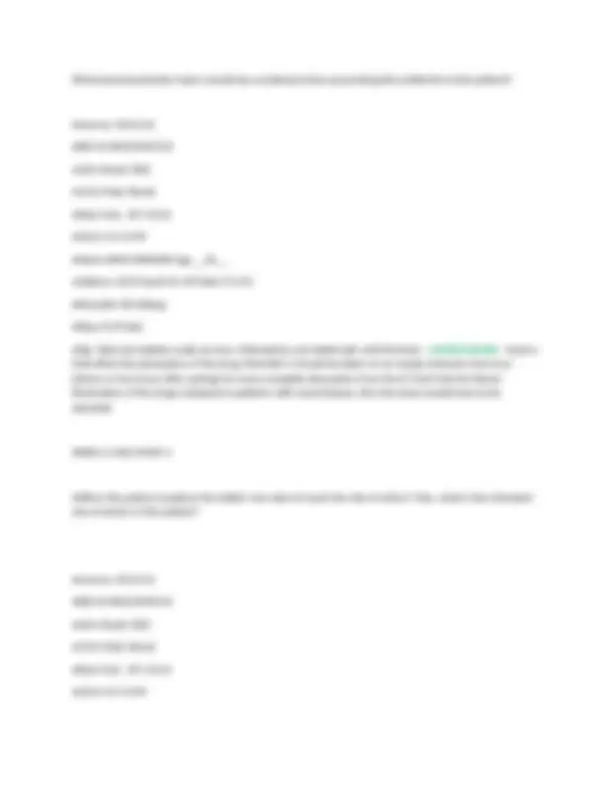
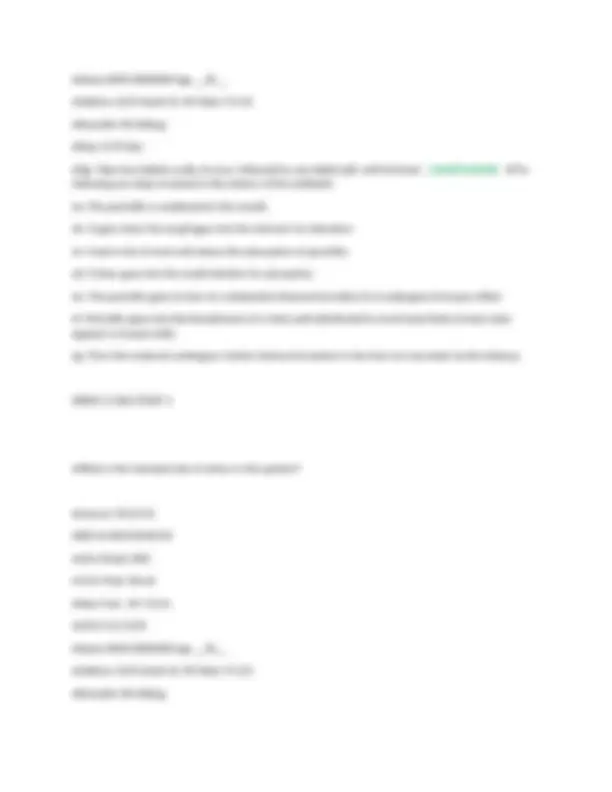
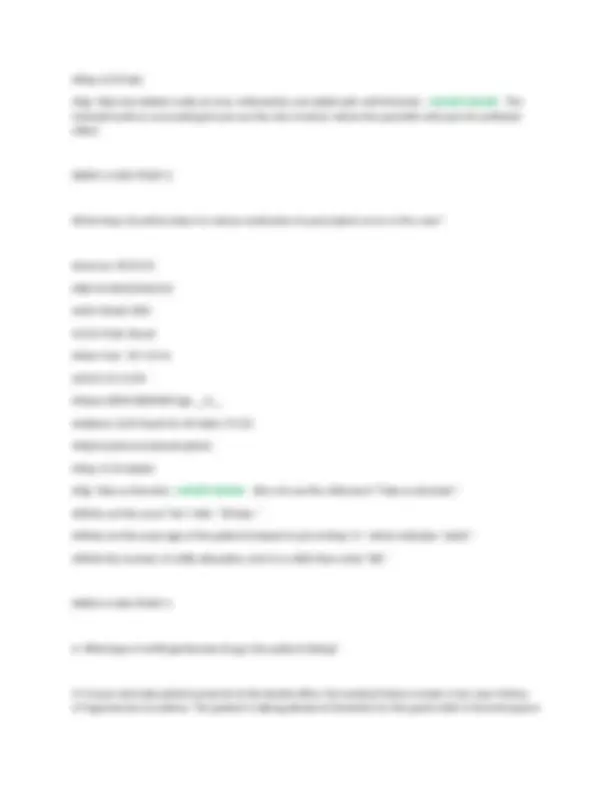
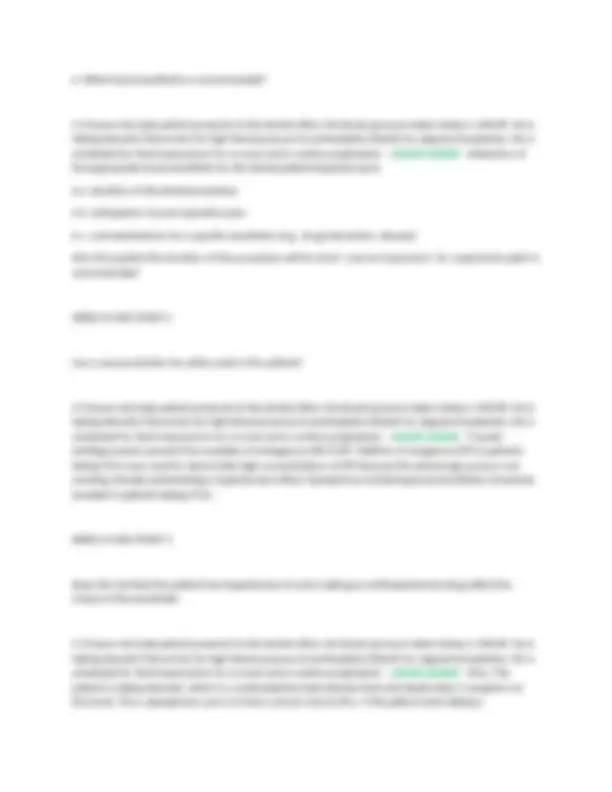
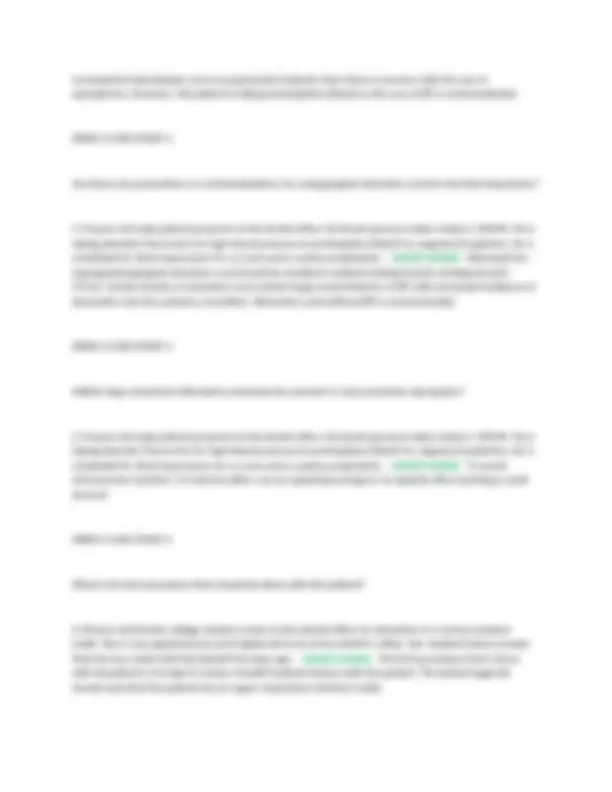
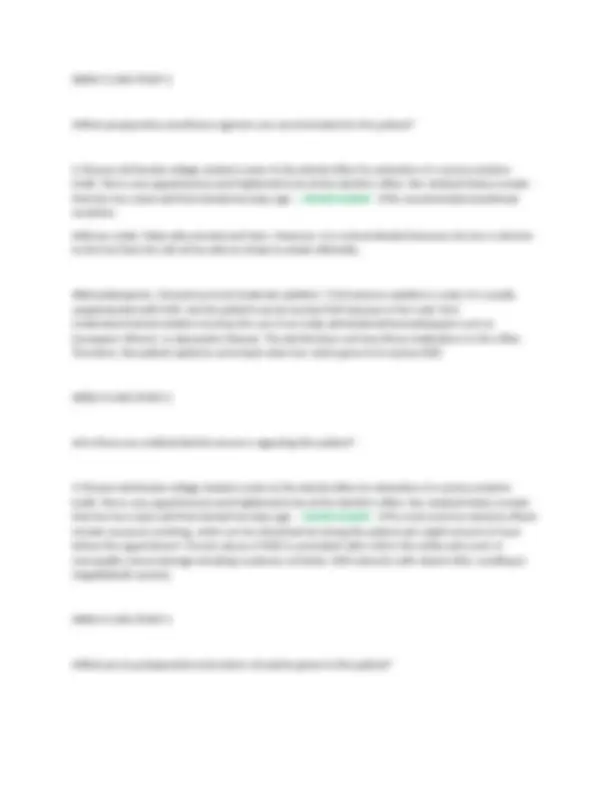
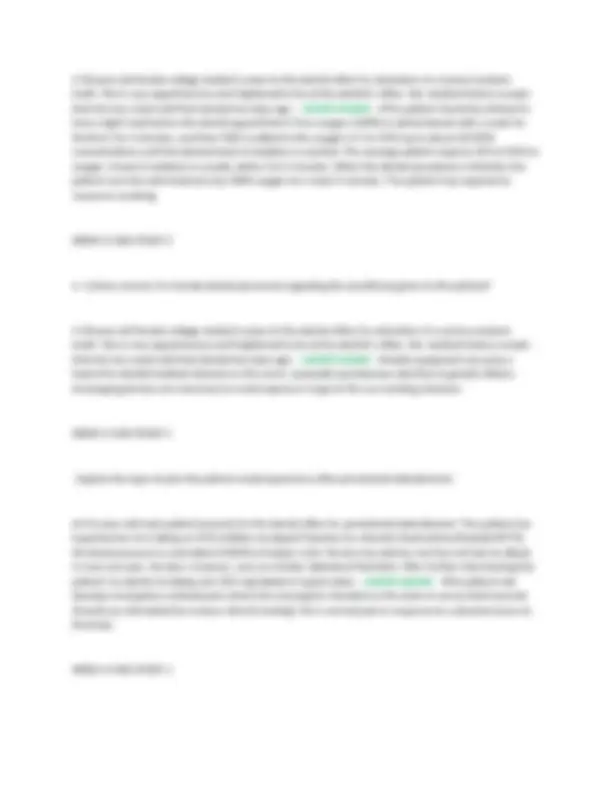
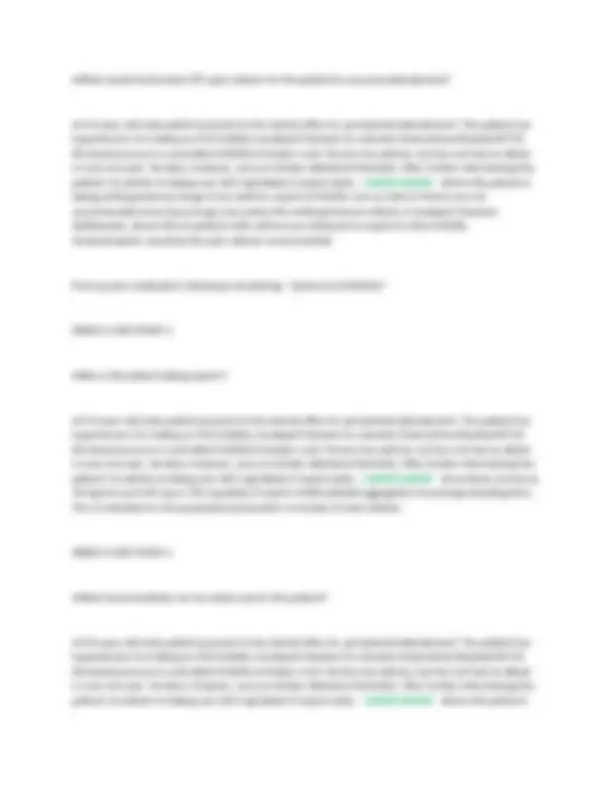
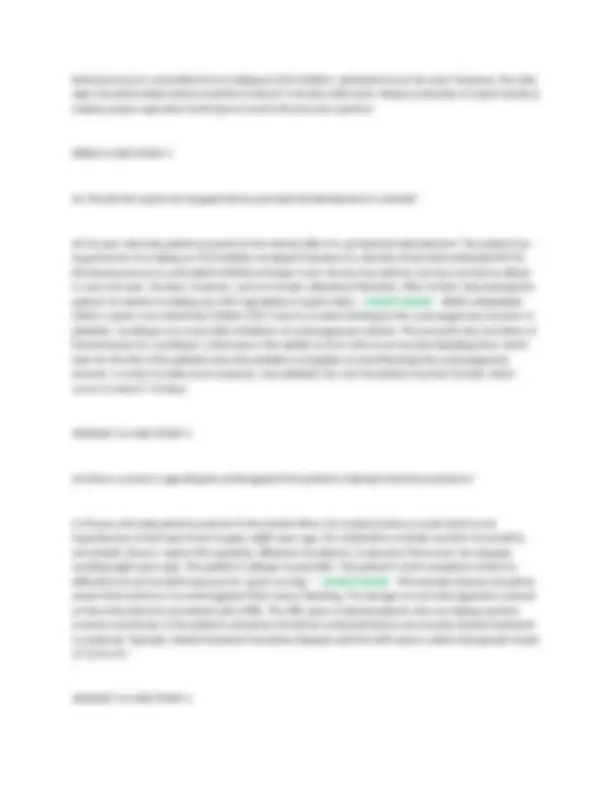
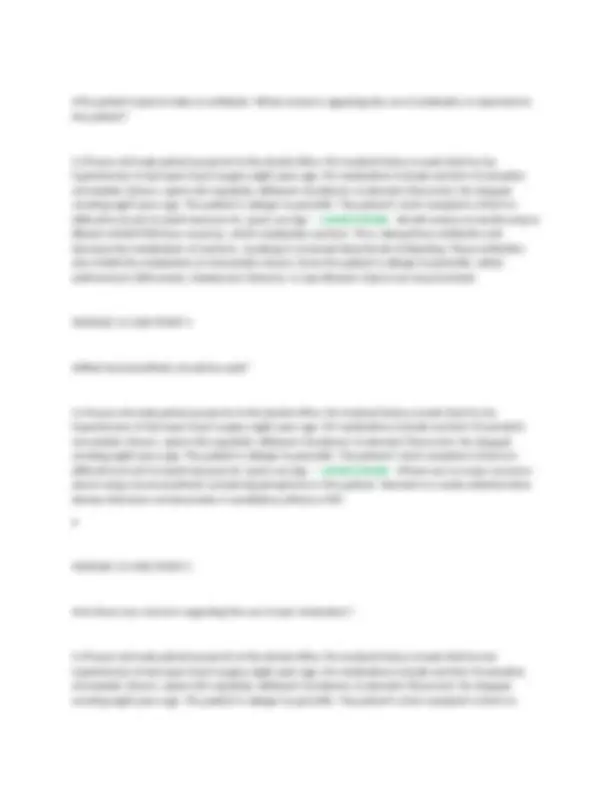
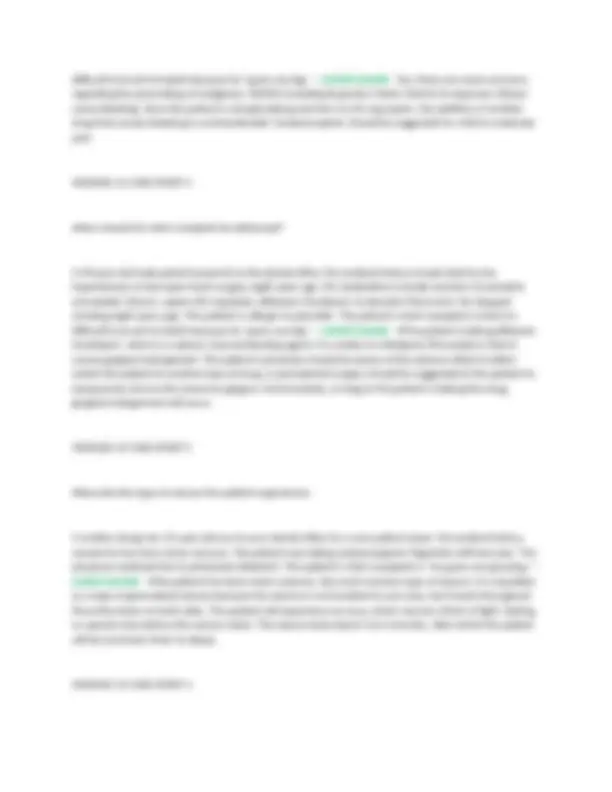
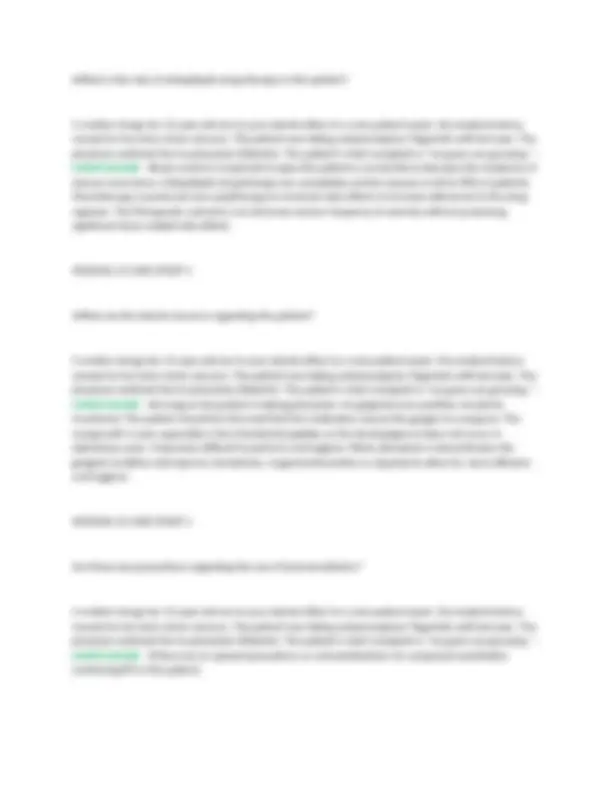
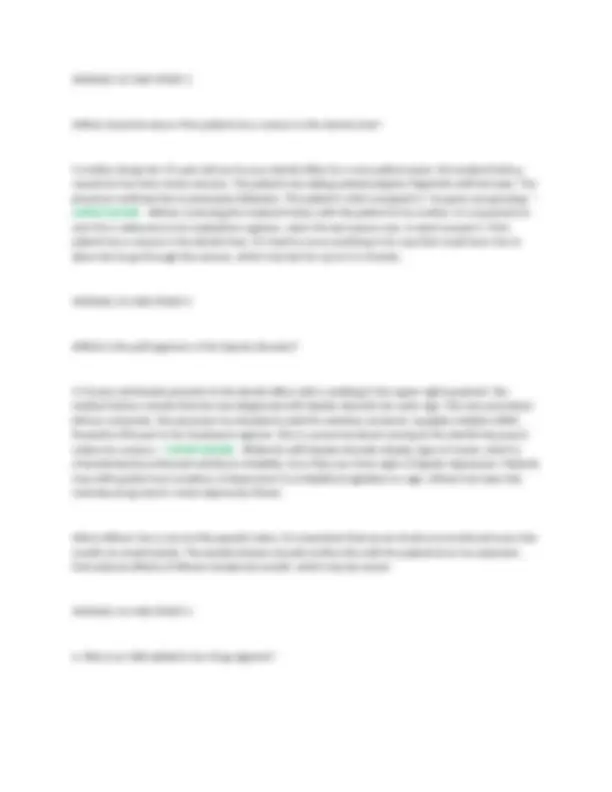
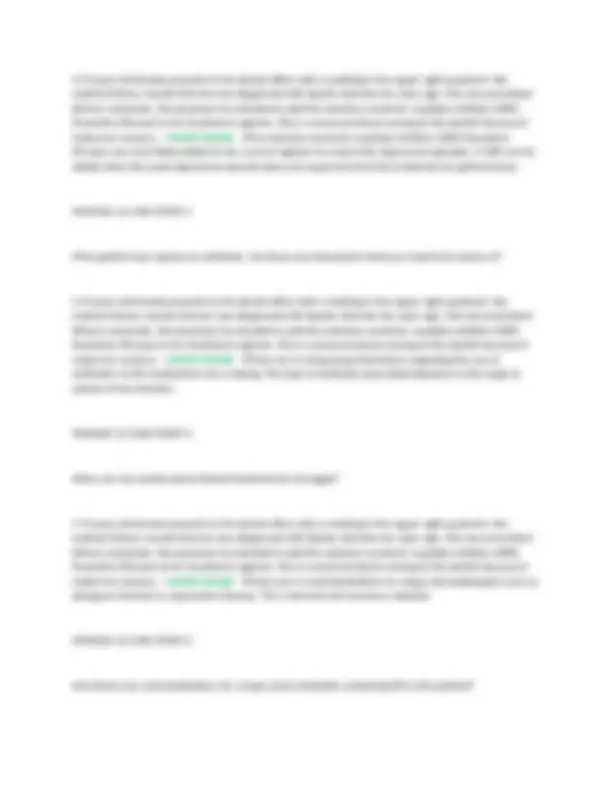

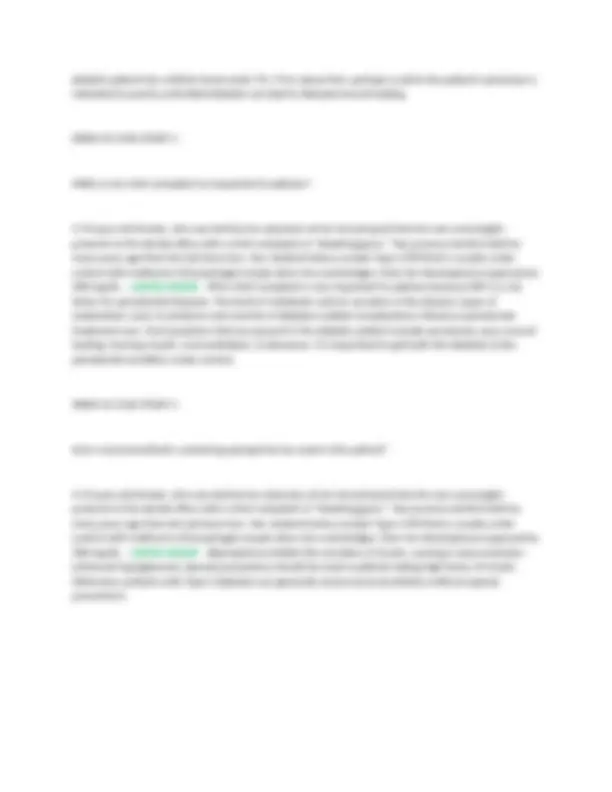


Study with the several resources on Docsity

Earn points by helping other students or get them with a premium plan


Prepare for your exams
Study with the several resources on Docsity

Earn points to download
Earn points by helping other students or get them with a premium plan
Community
Ask the community for help and clear up your study doubts
Discover the best universities in your country according to Docsity users
Free resources
Download our free guides on studying techniques, anxiety management strategies, and thesis advice from Docsity tutors
CASE STUDIES FINAL EXAM GRADED A+.
Typology: Exams
1 / 30

This page cannot be seen from the preview
Don't miss anything!























Case study # A patient presents for an emergency appointment for a toothache. He is a new patient. Upon reviewing his medical history, he keeps yawning, and falling asleep. When taking his BP you notice his pupils are small and fixed. His BP is 100/62. When you ask about the toothache, he says he doesn't care about the tooth and just wants it out. He says he is in a lot of pain and really needs some meds. What are the key points of this case study? - correct answer the patient is yawning and falling asleep His pupils are fixed and pinpoint His BP is 100/ patient doesn't care and is asking for meds Case study # you get a feeling that this patient is under the influence of something. What do you think it is? - correct answer Given the drowsiness and pinpoint fixed pupils it can be safe to assume that he is under the influence of an opioid/ narcotic medication Case Study # If this patient were to require an extraction today, which local anesthetic would be recommended - correct answer You would use a LA without a vasoconstrictor, to not proteinate the cardiac effects of it. 3% Mepivacaine (Carbocaine) would be the best LA Case Study # If this patient required pain medication, what would you recommend? - correct answer Due to the potential for continued abuse, we would avoid narcotics/ opioids. Therefore, we would suggest an NSAID (ibuprofen); possibly back to back with acetaminophen
Case study # A patient presents for a perio debridement. Upon reviewing medical history, he has a history of a heart murmur (mitral valve prolapse) and takes a premed of amoxicillin for it. 2 grams, 4 tabs one hour before his appointment. He isn't on any other meds, although he did mention having a knee replacement 4 months ago. what are the key points? - correct answer He is there for a perio debridement History of heart murmur takes pre med knee replacement 4 months ago Case study # Why was this patient prescribed premed in the past for his heart murmur? - correct answer He was given antibiotics prophylactically in the past to minimize the risk of infective endocarditis (IE). This was previously known as subacute bacterial endocarditis (SBE). This is when bacteria are introduced into the bloodstream and could colonize the valve, proliferate and affect the function of the valve Case study # does this patient need to take his premedication today for his heart murmur - correct answer No, according to AHA guidelines from 2007, mitral valve prolapse is a condition for which antibiotics are no longer needed prophylactically. Case study # How would you proceed with the handling of this patient for today's appointment? - correct answer This patient does require premed due to the face that he had a knee replacement 4 months ago. In 2009 the recommendations changed and advise patients to take antibiotic prophylaxis for their lifetime. It is always advisable to check with the orthopedic surgeon. Case study #
-previous infective endocarditis -cardiac transplant with valve problems -congenital heart disease (unrepaired cyanotic heart disease, repair with prosthetic patch or device) Case study # What antibiotics and doses are used for patients who require antibiotic prophylaxis? - correct answer patients not allergic to penicillin -amoxicillin 2 grams 1 hour prior to treatment Patients allergic to penicillin -clindamycin 600mg 1 hour prior to treatment Case study # What should patients be told about the antibiotics that may be prescribed for prophylaxis? - correct answer Patients should be instructed to take premedication one hour prior to their treatment. And as with any medication, the clinician should explain possible side effects, potential reactions, and potential food/drug interactions. Case study # A patient comes to the office with the chief complaint "pain in his bottom gums" his med history reveals HIV positive and has had many med conditions relating to his disease including the one in the picture. He is taking Lopinavir and Ritonavir and Zalcitabine What are the key points - correct answer pain the bottom right gums HIV positive med conditions relating to the HIV
takes Lopinavir, Ritonavir and Zalcitabine Case study # Explain the theory behind the pharmacological therapy for this patient - correct answer Using two or more drug combinations for initial therapy is termed highly active anterioviral therapy. (HAART) and is the preferred initial regimen. The purpose of HARRT is to improve both survival and quality of life with a regimen using two or more of these classes to suppress viral replication and management or prevention of opportunistic infections Case study # Are there periodontal concerns for this patient? - correct answer YES. Examination of gingiva and periodontium is obviously an important part of dental care. Several types of periodontal diseases have been associated with HIV-infected individuals, including linear gingival erythemia, necrotizing ulcerative gingivitis, necrotizing ulcerative perio. Theses diseases are often seen when the CD4 count falls below 200 cells/mm^3 and are associated with progressive or advanced immunosuppression. It should be noted that not all HIV- infected patients have perio disease. Case study # are there any contraindications or precautions regarding the use of LA in this patient - correct answer The use of LA has not been associated with increased risk of intraoral infections. However, deep block injections can result in medical complications in patients with recent history of increased bleeding tendencies. In these cases, use infiltrations. Case study # Should there be antibiotic prophylaxis/ coverage for this patient? - correct answer There is no data supporting the need for routine antibiotic coverage to prevent bacteremia due to dental procedures in HIV- infected people. Antibiotic prophylaxis may be necessary, although not definite, when the CD count falls below 200 cells/mm^ Case study #
Case study # The patient is upset because she has to take her denture out at night. Explain to the patient the rationale for this. - correct answer It should be explained to the patient the importance of having a denture that fits, the impotence of removing and cleaning the tissues and dentures at night to prevent fungal infections Case study # What are the treatment options for this patient - correct answer First, the fit of the denture should be assessed. A reline of the denture may be necessary. If the patient does not have a high caries index, then it is recommended to prescribe either Nystatin oral suspension or pastille or clotrimazole troche. If the patient has a high caries index, then cream/ointment can be applied to the affected area. Case study # The patient says that the area does not hurt but she will use the medication for only one day. What should you tell the patient - correct answer Many fungal infections tend to recur after discontinuing drug treatment. Thus, antifungal drugs should be used about two days after the oral lesion disappear. Case study # A mother brings her 9-year-old son to the dental office with an emergency from a hockey game 4 hours ago. His med history us significant for asthma (mild persistent) and he has nasal polyps. Patient is really anxious about being at the office. He is being treated with Fluticasone (Flovent) inhaler. The exam reveals the max left central incisors was avulsed (knocked out) what are the key points? - correct answer pt has asthma and nasal polyps patient is anxious being treated with fluticasone (flovent) left max central incisors were avulsed teeth were avulsed 4 hours ago
Case study # are there any precautions to follow for dental treatment in this patient? - correct answer Fluticasone (Flovent) is a corticosteroid that is used in the long-term control of the inflammatory component of asthma. It is administered as an inhaler. There are not special precautions to follow regarding dental treatment. However, use of corticosteroid inhalers can cause growth of candida albicans resulting in oral fungal infections. Instruct parent to have child rinse his mouth with water after using the inhaler. These infections may require treatment with antifungal therapy or discontinuing treatment with the inhaler. Case study # Is it safe to administer LA containing EPI to this patient? - correct answer There is no contraindication to using EPI in this patient Case study # Are there any concerns regarding the use of the medication he is taking for asthma? - correct answer Adverse effects from inhaled corticosteroids are often cough and oral candidiasis (thrush). Lesions of candidiasis appear white on the mucosa and rub off when wiped with gauze. The patient should brush his teeth and rinse his mouth with water after every inhalation dose to prevent fungal infections Case study # Some dental clinicians and physicians recommend that patients brush their teeth after taking the inhaled steroid as a method of removing excess steroid from the mouth and improving dental hygiene. When a patient uses the inhaler with a valved holding chamber, the incidence of oral candidiasis ______ ________ - correct answer drops markedly Case study # What should be done to help manage the patient? - correct answer The child is in a lot of pain. A LA should be given to minimize the pain. It is important to keep the child comfortable because he is likely to develop asthmatic symptoms while under stress. This is likely the occur in well- controlled asthmatics.
Case study # Are there any blood count concerns once the patient starts chemo? - correct answer Yes. Bone marrow suppression is influenced by the type of drug used, patient's age, bone marrow reserve, the patient's nutritional status, and liver and kidney function. Bone marrow suppression causes anemia (low red blood cell count) neutropenia/leukopenia (low WBC count) there are limitations on treating a patient undergoing treatment for cancer. The majority of patients will have depressed WBC (neutrophils) which may increase the incidence of infections (signs of infection may be fever, malaise) and patients may also have low platelets, which may increase the incidence of bleeding. Case study # Why is oral care important for this patient - correct answer it may help the frequency and severity of OM and caries. Oral rinses such as saline(salt) water and sodium bicarbonate solutions may be soothing for OM. Anesthetics such as viscous lidocaine (swish in mouth and then spit out) and chlorohexidine rinse may also help Case study # patient presents to the dental office. The patient does not like to take conventional meds except one baby aspirin daily. He takes natural supplements, including St. John's wort, ginger and echinacea. He has been taking these for many years. The patient is scheduled for extractions and prio surgery. what are the key points - correct answer -Patient takes baby aspirin once daily -patient takes natural supplements (St. John's wort, ginger and echinacea) -patient is scheduled for extraction and perio surgery. Case study # What is a potential concern regarding the use of herbal supplements? - correct answer One concern is that dietary supplements are not approved by the FDA Case study #
Are there any precautions for using LA in this patient - correct answer No. There are no potential interactions with these natural products and LA Case Study # Are there any precautions regarding bleeding? - correct answer Yes. St. John's wort and garlic may have anti-platelet effects, which may be enhanced because the patient is taking aspirin. Case study # How should the patient be prepared for surgery? - correct answer Increased bleeding may be expected after invasive surgical procedures. Discontinue the herbs 7 to 10 days before surgery Case study # If the patient requires analgesics after the surgery, are there any precautions? - correct answer Yes, Since the patient is already taking 81mg aspirin and there is an increased bleeding tendency with the herbs he is taking, therefore an NSAID is contraindicated. It is best to recommend acetaminophen WEEK 1 CASE STUDY 1 Why is it important to ask this patient if she has had any allergies? •License: 0111111 •DEA # AW •John David, DDS •1111 Main Street •New York , NY 11111 •(212) 111-
What pharmacokinetic factor should be considered when prescribing this antibiotic to the patient? •License: 0111111 •DEA # AW •John David, DDS •1111 Main Street •New York , NY 11111 •(212) 111- •Name XXXX XXXXXXX Age 35 •Address 1234 South St, NY Date 7/1/ •Penicillin VK 500mg •Disp: # 29 tabs •Sig: Take two tablets orally at once, followed by one tablet q6h until finished. - correct answer factors that affect the absorption of the drug. Penicillin V should be taken on an empty stomach (one hour before or two hours after eating) for more complete absorption from the GI tract into the blood. Elimination of the drug is delayed in patients with renal disease, thus the dose would have to be adjusted. WEEK 1 CASE STUDY 1 •When the patient swallows the tablet, how does it reach the site of action? Also, what is the intended site of action in this patient? •License: 0111111 •DEA # AW •John David, DDS •1111 Main Street •New York , NY 11111 •(212) 111-
•Name XXXX XXXXXXX Age 35 •Address 1234 South St, NY Date 7/1/ •Penicillin VK 500mg •Disp: # 29 tabs •Sig: Take two tablets orally at once, followed by one tablet q6h until finished. - correct answer •The following are steps involved in the actions of the antibiotic: •a. The penicillin is swallowed in the mouth. •b. It goes down the esophagus into the stomach for liberation. •c. Food in the GI tract will reduce the absorption of penicillin. •d. It then goes into the small intestine for absorption. •e. The penicillin goes to liver for metabolism/biotransformation & it undergoes first-pass effect •f. Penicillin goes into the bloodstream & is fairly well-distributed to most body fluids & bone (also appears in breast milk). •g. Then the molecule undergoes further biotransformation in the liver & is excreted via the kidneys. WEEK 1 CASE STUDY 1 •What is the intended site of action in this patient? •License: 0111111 •DEA # AW •John David, DDS •1111 Main Street •New York , NY 11111 •(212) 111- •Name XXXX XXXXXXX Age 35 •Address 1234 South St, NY Date 7/1/ •Penicillin VK 500mg
during asthma attacks. His last asthmatic attack was 6 months ago. For hypertension, the patient is taking atenolol (Tenormin). He is scheduled to have periodontal debridement & various restorative procedures - correct answer The patient is taking atenolol (Tenormin), which is the prototype selective beta-1 blocker. Since it is cardioselective, it does not block beta-2 receptors. Thus, there are no effects on the lungs WEEK 2 CASE STUDY 1 •. What type of asthmatic drug is the patient taking? A 51-year-old male patient presents to the dental office. His medical history reveals a four year history of hypertension & asthma. The patient is taking albuterol (Ventolin) for the quick-relief of bronchospasm during asthma attacks. His last asthmatic attack was 6 months ago. For hypertension, the patient is taking atenolol (Tenormin). He is scheduled to have periodontal debridement & various restorative procedures - correct answer The patient is taking albuterol (Ventolin), which is the prototype quick- relief selective beta-2 agonist. When inhaled, the beta-2 agonists provide the quickest onset (5- minutes) and relief of symptoms by bronchodilation (relaxation of bronchial smooth muscle). WEEK 2 CASE STUDY 1 •Are there any dental concerns associated with these medications? A 51-year-old male patient presents to the dental office. His medical history reveals a four year history of hypertension & asthma. The patient is taking albuterol (Ventolin) for the quick-relief of bronchospasm during asthma attacks. His last asthmatic attack was 6 months ago. For hypertension, the patient is taking atenolol (Tenormin). He is scheduled to have periodontal debridement & various restorative procedures - correct answer •The dental hygienist should have the patient place the inhaler within reach for emergency use. Also, inhalers can cause fungal infections. The patient should be instructed to rinse his mouth after each use. WEEK 2 CASE STUDY 1
A 51-year-old male patient presents to the dental office. His medical history reveals a four year history of hypertension & asthma. The patient is taking albuterol (Ventolin) for the quick-relief of bronchospasm during asthma attacks. His last asthmatic attack was 6 months ago. For hypertension, the patient is taking atenolol (Tenormin). He is scheduled to have periodontal debridement & various restorative procedures - correct answer •Atenolol: The patient's vital signs should be monitored. Have the patient remain in an upright position for a few minutes before getting up from the dental chair to avoid orthostatic hypotension. Monitor the patient for dry mouth by assessing salivary flow. Monitor for caries & periodontal disease. •Albuterol inhaler: oral effects include tasterm-57te changes, dry mouth & throat. The patient's salivary flow should be assessed as a factor in dental/root caries, periodontal diseases, & oral candidiasis. A stress-reduction protocol should be followed for anxious patients. The patient should be instructed to brush teeth (when possible) & rinse mouth with water after each dose to prevent dryness of the oral cavity. Assess the need for fluoride supplements. WEEK 2 CASE STUDY 1 Are there contraindications to the use of local anesthesia with epinephrine in this patient? A 51-year-old male patient presents to the dental office. His medical history reveals a four year history of hypertension & asthma. The patient is taking albuterol (Ventolin) for the quick-relief of bronchospasm during asthma attacks. His last asthmatic attack was 6 months ago. For hypertension, the patient is taking atenolol (Tenormin). He is scheduled to have periodontal debridement & various restorative procedures - correct answer •The decision to use a local anesthetic containing epinephrine depends on the type of antihypertensive drug used. Since atenolol is a cardioselective beta-1 blocker, it does not affect the beta-2 receptors. no major concern with the use of EPI. On the other hand, a non-selective beta-blocker such as propranolol (Inderal) blocks the beta- vasodilatory effects of EPI, potentially causing a hypertensive crisis. Thus, EPI should be minimally used ("cardiac dose"). Albuterol is a selective beta-2 agonist that causes relaxation or bronchodilation of the bronchial muscle. There is no major concern with the use of EPI in asthmatic patients. WEEK 3 CASE STUDY 1
nonselective beta blocker such as propranolol (Inderal), then there is concern with the use of epinephrine. However, the patient is taking amitriptyline (Elavil) so the use of EPI is contraindicated. WEEK 3 CASE STUDY 1 Are there any precautions or contraindications for using gingival retraction cord for the final impression? A 53-year-old male patient presents to the dental office. His blood pressure taken today is 140/84. He is taking atenolol (Tenormin) for high blood pressure & amitriptyline (Elavil) for migraine headaches. He is scheduled for final impressions for a crown and a routine prophylaxis. - correct answer •Epinephrine- impregnated gingival retraction cord should be avoided in patients taking tricyclic antidepressants (TCAs). Certain brands of retraction cord contain large concentrations of EPI with increased incidence of absorption into the systemic circulation. Retraction cord without EPI is recommended. WEEK 3 CASE STUDY 1 •What steps should be followed to minimize the amount of vasoconstrictor absorption? A 53-year-old male patient presents to the dental office. His blood pressure taken today is 140/84. He is taking atenolol (Tenormin) for high blood pressure & amitriptyline (Elavil) for migraine headaches. He is scheduled for final impressions for a crown and a routine prophylaxis. - correct answer To avoid intravascular injection, it is best to either use an aspirating syringe or to aspirate after injecting a small amount WEEK 3 CASE STUDY 2 What is the first procedure that should be done with this patient? A 20-year-old female college student comes to the dental office for extraction of a carious wisdom tooth. She is very apprehensive and frightened to be at the dentist's office. Her medical history reveals that she has a bad cold that started two days ago. - correct answer The first procedure that is done with all patients is to take & review a health/medical history with the patient. The dental hygienist should note that the patient has an upper respiratory infection (cold).
•What preoperative anesthesia regimens are recommended for this patient? A 20-year-old female college student comes to the dental office for extraction of a carious wisdom tooth. She is very apprehensive and frightened to be at the dentist's office. Her medical history reveals that she has a bad cold that started two days ago. - correct answer •The recommended anesthesia would be: •Nitrous oxide: Helps allay anxiety and fears. However, it is contraindicated because she has a cold due to the fact that she will not be able to inhale & exhale efficiently. •Benzodiazepines: Intravenous/oral moderate sedation. If intravenous sedation is used, it is usually supplemented with N2O, but the patient cannot receive N2O because of her cold. Oral moderate/minimal sedation involves the use of an orally administered benzodiazepine such as lorazepam (Ativan), or alprazolam (Xanax). The dentist does not have these medications in the office. Therefore, the patient opted to come back when her cold is gone & to receive N2O. WEEK 3 CASE STUDY 2 •Are there any medical/dental concerns regarding this patient? A 20-year-old female college student comes to the dental office for extraction of a carious wisdom tooth. She is very apprehensive and frightened to be at the dentist's office. Her medical history reveals that she has a bad cold that started two days ago. - correct answer •The most common adverse effects include nausea & vomiting, which can be minimized by having the patient eat a light amount of food before the appointment. Chronic abuse of N2O is associated with a fall in the white-cell count, & neuropathy (nerve damage including numbness of limbs). N2O interacts with vitamin B12, resulting in megaloblastic anemia. WEEK 3 CASE STUDY 2 •What pre & postoperative instructions should be given to this patient?